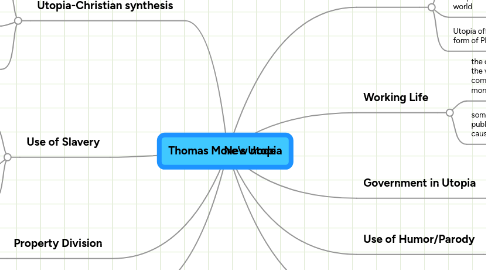Thomas More's Utopia
作者:esther lee

1. Utopia-Christian synthesis
1.1. The great Christian aspect of the synthesis is Christ's gospel of caring for the poor, the oppressed and the downtrodden
1.2. The Platonic, Republican tradition is the Greek aspect of the synthesis
1.3. More wrote Utopia with a comedic tone, allowing him to speak his truth while telling a deeper story
2. Property Division
2.1. There is no private ownership on Utopia, with goods being stored in warehouses and people requesting what they need. There are also no locks on the doors of the houses, which are rotated between the citizens every ten years
3. Use of Slavery
3.1. Slavery is a feature of Utopian life and it is reported that every household has two slaves
3.2. The slaves are either from other countries or are the Utopian criminals.
3.3. Slaves are periodically released for good behaviour.
4. New node
5. How to Find Happiness
6. Overview
6.1. Thomas More's Utopia is a Christian-humanist view of an ideal society
6.2. More does not simply offer a theoretical view, but provides specifics for how to create this world
6.3. Utopia offers a Christianized form of Plato's Republic
7. Use of Humor/Parody
7.1. Utopia means no where- The title is a joke
8. Working Life
8.1. the communistic life style of a Utopian shows the value that More placed on a simpler communal life, reflecting his longing for monastic duties
8.2. some see it as reflecting his pride in public service and working for a common cause.
9. Government in Utopia
9.1. a welfare state with free hospitals, euthanasia permissible by the state, priests being allowed to marry, divorce permitted, premarital sex punished by a lifetime of enforced celibacy and adultery being punished by enslavement
10. Social critique of Great Britain
10.1. New node


